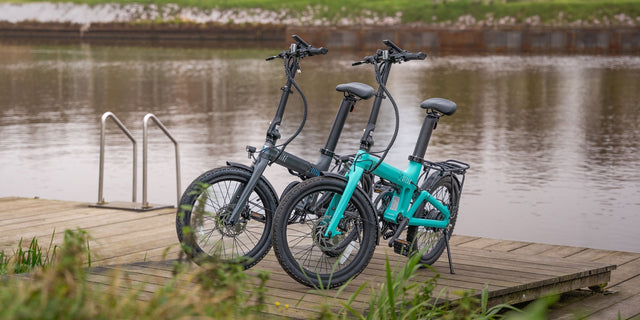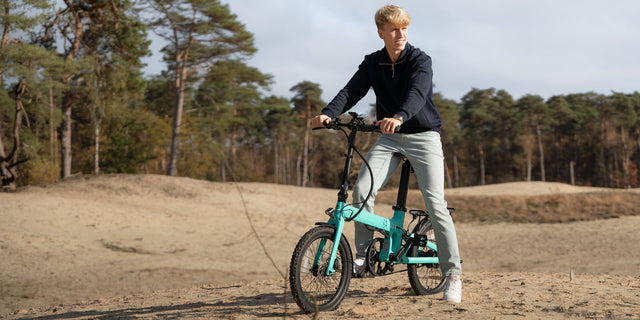Pedal‑assist (PAS) is the simple idea that makes e‑bikes feel natural: you pedal, a small motor adds a smooth boost, and you ride further with less effort. No throttles, no complicated controls—just cycling, with help when you want it. In this guide, we explain how PAS works, how different sensors change the feel of your ride, how to choose and use PAS levels, and a few easy techniques to make every ride smoother and more efficient.
All T‑Bike models comply with UK/EU EPAC/EAPC rules: assistance up to 25 km/h and a 250 W (continuous) motor. That means you still pedal for exercise and control, while the motor quietly supports your effort. If you’re riding on canals, around campsites or through town, PAS makes things easier, hill starts feel calmer and more confident.
How pedal‑assist works (quick overview)
- Your pedalling is detected by a sensor near the crankset (pedals).
- A controller adds motor power based on the PAS level you’ve selected (and sometimes how hard you’re pedalling).
- Power ramps in and out to feel predictable, with a top‑speed assist limit of 25 km/h in the UK/EU.
- You remain fully in control: braking, changing gear and choosing the PAS level shapes how much assistance you recieve from the motor.
Sensors: cadence vs torque (and hybrids)
Choosing the right sensor is mostly about the ride feel you prefer. Here’s how they differ.
Cadence sensors (on/off based on pedalling)
- What it does: Detects that the cranks are turning; assistance engages once you’re pedalling.
- Ride feel: Predictable, steady boost at each PAS level. Great for relaxed cruising and urban riding.
- Pros: Simple, consistent assistance; often more budget‑friendly; easy learning curve.
- Consider if: You want calm, straight forward support for city rides and leisure loops.
Torque sensors (proportional to effort)
- What it does: Measures how hard your feet push on the pedals; adds power in proportion to your effort.
- Ride feel: Very “natural,” responsive to hills and acceleration feels like you have stronger legs.
- Pros: Intuitive control on varied terrain; can encourage efficient pedalling technique.
- Consider if: You value a more athletic feel or ride across rolling terrain where effort varies.
Hybrid systems (cadence + torque)
- What it does: Combines both signals; gives predictable starts and nuanced control once rolling.
- Ride feel: Balanced—smooth pull‑away, then proportional support as effort changes.
- Pros: Best‑of‑both for mixed riding; confidence at junctions, refinement on longer rides.
- Consider if: You split time between town links and longer leisure rides.
Tip: Sensor type affects “how” power is delivered more than “how much” power the electric bike has. For everyday riders, feel and predictability matter more than peak specs.
PAS levels, ramp rates and responsiveness
Your display/controller lets you choose support from low to high (1 → 5 on the T‑Bike range). The level you choose adjusts two things:
- Assist amount: Higher levels add more power at a given effort/cadence.
- Ramp/response: Some systems increase how quickly power arrives when you start pedalling.
Practical guidance:
- Start low in busy areas: PAS Level 1 makes pull‑aways smoother at junctions and on towpaths.
- Step up for hills or headwinds: Mid levels (PAS 3–4) prevent over‑revving your cadence and keep speed steady.
- Use high briefly: Reserve the top level (PAS 5) for short climbs, heavy loads or strong headwinds.
Ride techniques that make PAS feel great
- Aim for a steady cadence of ~60–80 rpm, steady consistent pedalling. E‑bike motors are most efficient when you spin rather than grind.
- Change down before you stop. A low gear and having the PAS level set to low makes starts smooth and controlled.
- Feather PAS like gears. Treat levels as “virtual tailwinds” you add or remove to match the moment.
- Look ahead on hills. Add one PAS level a few seconds before the climb to keep momentum.
- Use walk‑assist when appropriate. For steep ramps, walk‑assist helps you move the bike safely off the saddle (check your model’s manual and local rules).
Range and battery care (real‑world)
- Expect more range in mild weather on flatter routes at lower PAS levels; less range with hills, wind, cold and higher cycling speeds.
- Tyre pressure, cadence and using the correct gear matter. Under‑inflated tyres and low cadence reduce efficiency.
- Top up smartly. Partial charges are fine for lithium cells; avoid leaving the battery at 0% or 100% for long periods.
- Learn more: see Range basics in E‑Bike Range Explained and use the calculator linked there to plan your day rides.
Legal and safety (UK/EU EPAC/EAPC)
- Assist limit: up to 25 km/h; the motor doesn’t propel you beyond this.
- Motor rating: 250 W (continuous) with pedal‑only assistance (no throttle for road use).
- Age and rules vary by country—check details in our UK E‑Bike Legal Guide.
- Fit lights, use a bell, and ride courteously—especially on shared paths.
FAQs
Do torque sensors save battery?
Not automatically. They help you modulate effort more precisely, which can reduce wasted power on flats and gentle hills. Real savings come from smooth cadence, appropriate gears and moderate speeds.
Which sensor feels most natural?
Most riders say torque or hybrid systems feel closest to “stronger legs,” especially on rolling terrain. If you prefer a steady, set‑and‑forget boost for urban links, cadence systems feel wonderfully predictable.
Which sensors are fitted to the T‑Bike folding electric bikes?
| T-Bike Model | Sensor Type |
|---|---|
| LR250 | Torque |
| CR250 | Torque |
| CITY250 | Speed |
| CF250 | Torque |
If you would like to find out more about the T-Bike range and how each model feels to ride, book a test ride.
Mehr Artikel

How to Choose the Right T‑Bike Folding Electric Bike


